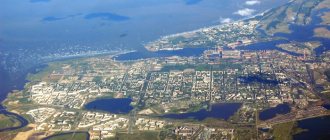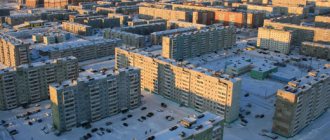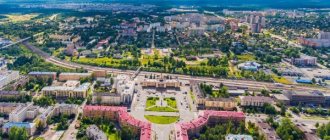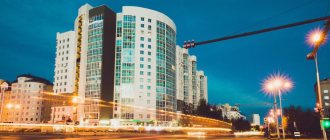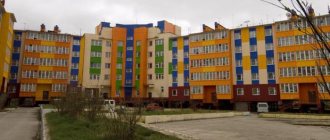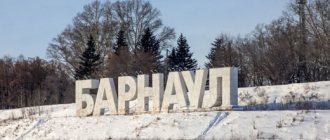Kuban is the largest river in the North Caucasus. The Bolshoy Zelenchuk River flows into it. A large cape formed at the confluence. It was on it that Nevinnomyssk was founded. This situation is reflected in the city coat of arms - two blue stripes converge on a golden field, forming a green triangle. The city is the starting point for many tourist routes in the North Caucasus.
Coat of arms of Nevinnomyssk
Nevinnomyssk on the map
Nevinnomyssk is located in the Ciscaucasia region on an elevated part of the Stavropol Territory, along the banks of the calm Kuban River, which merges with a watercourse called Bolshoi Zelenchuk. The city is located 55 km from Stavropol at an altitude of 343 m above sea level. m.
It covers an area of more than 100 km2. The settlement received its name thanks to the Nevinka River, which flows near the station. Ust-Nevinka.
Despite its small territory, Nevinnomyssk is divided into the following districts:
- PRP;
- Center;
- Head;
- spare parts;
- Red Village;
- MZHK;
- Old city;
- Comet;
- Mill;
- Pravokubansky;
- Rozhdestvenka;
- House of Life;
- Factory.
The city has moderate continental climatic conditions. Winters here are long and mild with average January temperatures of 80 C. Summers are fleeting and hot. The average July temperature is +160 C.
Sources
- Government of the Stavropol Territory. Resolution No. 63-p of May 4, 2006 “On approval of the register of administrative-territorial units of the Stavropol Territory,” as amended. Resolution No. 75-p dated March 5, 2015 “On amendments to paragraph 47 of Section II of the Register of administrative-territorial units of the Stavropol Territory, approved by Decree of the Government of the Stavropol Territory dated May 4, 2006 No. 63-p.” Came into force on May 4, 2006. Published: “Collection of laws and other laws of the Stavropol Territory”, No. 17, Art. 5609, July 10, 2006 (Government of the Stavropol Territory. Resolution No. 63-r dated May 4, 2006 On approval of the Register of administrative-territorial units of the Stavropol Territory
As amended by Resolution No. 75-r dated 03/05/2015
On amendments to paragraph 47 section II of the register of administrative-territorial units of the Stavropol Territory, adopted by Decree of the Government of the Stavropol Territory of May 4, 2006 No. 63-p.
Valid from May 4, 2006). - State Duma of the Stavropol Territory. Law No. 88-kz of October 4, 2004 “On granting municipalities of the Stavropol Territory the status of an urban, rural settlement, urban district, municipal district,” as amended. Law No. 51-kz of May 28, 2015 “On the transformation of municipalities that are part of the Mineralovodsk municipal district of the Stavropol Territory (Mineralovodsk territorial municipal formation of the Stavropol Territory), and on the organization of local self-government in the territory of the Mineralovodsk district of the Stavropol Territory.” Came into force on the date of official publication. Published: “Stavropolskaya Pravda”, No. 216, October 6, 2004 (State Duma of the Stavropol Territory. Law No. 88-kz of October 4, 2004
B to
municipalities of the Stavropol Territory edition of the Law of May 28, 2015 No. 51-kz. On the transformation of municipalities within the Mineralovodsk municipal district of the Stavropol Territory (Mineralovodsk territorial municipal formation of the Stavropol Territory) and on the organization of local self-government in the territory of the Mineralovodsk district of the Stavropol Territory
. Valid from the date of official publication.).
Steles framing the city
Steles rise on both sides of the city:
- One of them stands at the entrance to the village from the Stavropol direction. The monument is a stone structure, in the lower part of which the name of the city is written, and on one side of the monument there is a high pillar.
- Another memorial plaque is located at the entrance to the settlement on the side of Mineralnye Vody. It is dedicated to workers in the energy industry and the production of energy. The stele was installed on the street. Power engineers, not far from the hydroelectric power station.
A monument in the form of a male figure was erected nearby in 2008. In one of his palms lies a gear with outgoing energy radiation, and in the other he holds the sun. The man's face is turned to the sky. The monument is made of stainless steel and covered with silver paint.
The statue stands on a high pedestal, on which the word “GRES” is written in huge font.
Museum of Local Lore
The city museum of local lore was founded in 1957 as the “Exhibition of Military Glory.” A collection of 500 items was assembled as exhibits. Eight years later, by decision of the city authorities, the exhibition was transformed into a museum of labor, military and revolutionary glory.
Since the end of the twentieth century. The institution is an independent staff structure under the Culture Committee and is called the Nevinnomyssk Local Lore and History Museum. In the same year, he was moved to a separate modern building located in a residential area of the central part of the city on the street. Gagarina 43b.
Nevinnomyssk has a rich history, which can be found in the city local history museum
There are several halls here:
- Expositional, telling about the history of the city, from its first inhabitants to the present day.
- An exhibition hall, distinguished by the fact that it has monthly changing expositions of different directions. Often exhibitions are placed in the building's lobby.
- Here they constantly conduct excursions and give lectures for city schoolchildren, students and military people.
For the exhibition dedicated to the Second World War, many new exhibition complexes were created in the historical hall. Currently, the museum collection includes about 12.3 thousand items. The institution's funds are constantly replenished thanks to local residents. The museum is open to visitors every day from 9.00 to 17.00, except Mon.
An adult entrance ticket costs 5 rubles, and for a child ticket you need to pay 2 rubles.
A FEW WORDS ABOUT THE CIVIL WAR
The introductory historical part could have ended here, but I really want to touch on the topic of the Civil War just a little bit.
With its onset, the village of Nevinnomyssk, like most villages and cities in our country, was divided into two camps. On the one hand there were workers of enterprises who fought, as usual, on the side of the Soviet regime, and on the other side there were Cossacks who preferred the side of the White Guard.
As in the film “Wedding in Malinovka,” the village repeatedly passed from hand to hand, first one, then another.
So, my great-great-grandfather on the cousin’s side, I.A. Kochubey, a hereditary Cossack, initially, immediately after being drafted, fought for the whites, and then, for ideological reasons, went over to the side of the reds.
And after some time, he had a conflict with the Soviet authorities, and already in February 1919 he was accused, first of anarchy, then of abuse of power, laxity, and ultimately, he was arrested and put under arrest. While he was under arrest and waiting for clarification of the current situation, the village was occupied by whites. After interrogation and refusal I.A. Kochubey about collaboration with the whites, he was sentenced to death by a military court and hanged.
Now there are a lot of false experts and “experts” on this period, who want to either embellish one side while denigrating the other, or vice versa.
For me, the civil war is perhaps one of the most terrible periods in history. It’s one thing when the enemy is a fascist, and quite another when the enemy is your brother or father, friend or neighbor.
Isn't this a tragedy? And I think it’s a sin to publicize on tragedy and misfortune.
That's how my great-grandfather is. He fought honestly, risked his life for the ideals that he understood and accepted, for what was dear to him and for those whom he simply loved. Maybe he even made a mistake somewhere, but there is no point in judging and, especially, condemning him for this.
Many districts, villages and towns, as well as streets and squares in different cities are named in his honor. A decent number of monuments and busts have been erected, several books have even been written and the film “Kochubey” has been filmed. By the way, at the time of his death, he was only 25 years old.
Monuments to the Cossacks
Nevinnomyssk is located in a historical area that was conquered by people at the cost of their own lives. In 2012, not far from the mass grave on the street. Revolutionary, 18, a monument to the founding Cossacks was unveiled in an official setting.
Don't miss the most popular article in the section: Metro Nizhny Novgorod. Diagram, map, description.
The sculptural complex is dedicated to the local Cossacks, who protected Art. Nevinnomysskaya in 1842 and died heroically. The monument is a massive block in the form of a worship cross, installed on a marble platform. The sculpture is topped with a steel cross.
The names of 17 dead Khoper residents are carved on the stone.
Authorities
The city's local government bodies include:
- City Duma - city body;
- the mayor of the city is the head of the municipality who heads the city administration;
- city administration - the executive and administrative body of the city;
- Chamber of Control and Accounts of the city.
Mayor
- Anatoly Semenchenko;
- Victor Ledovsky;
- Konstantin Khramov
- IN. from March to July 2012 - Tatyana Vasilchenko;
- from July 2012 to April 21, 2015 - Sergey Batynyuk;
- from April 21, 2015 to November 17, 2016 - Nadezhda Bogdanova;
- from November 17, 2016 - Mikhail Minenkov.
Heads of Administration:
- until April 2015 - Sergey Batynyuk;
- from May 29, 2015 to November 2016 - Vasily Shestak.
- Since November 2016, the post of head of administration has been combined with the head of the city.
Chairman of the City Duma
- Alexander Medyanik.[10]
Monument to the 85mm anti-aircraft gun
The grand opening of the monument to the Anti-Aircraft Cannon took place in 1981. The Obelisk was placed on Mira Blvd. It looks like an 85mm anti-aircraft gun standing on a low cast iron platform. The pedestal is made in the form of a rectangular figure, one edge of which is higher than the other.
Due to this circumstance, the cannon is directed upward, which indicates its main purpose - to destroy as many enemy aircraft as possible. The sculptural composition reminds local residents of the hot summer of 1942, when soldiers of the 18th Artillery Division, at the cost of their own lives, recaptured their hometown from the Nazis.
Cathedral of the Intercession of the Blessed Virgin Mary
The Church of the Intercession of the Blessed Virgin Mary is considered the largest church community in the Stavropol diocese. At the same time, it can accommodate about 1.5 thousand parishioners. At the turn of the 20th and 21st centuries. the temple was elevated to the rank of a cathedral. The village of Nevinnomyssk was founded on the day of the Intercession of the Mother of God, and a holy place was also founded with the name Pokrovsky.
The old church stood in the middle of the settlement, but after the revolution it was destroyed. On the 100th anniversary of the Baptism of Rus', it was decided to build a new temple in Nevinnomyssk. A competition was announced for the best design for the future cathedral. As a result, they chose the project of S. Rudik. Construction lasted for 10 years.
In 1992, on Easter, the first service was held in the still unfinished building. The church was built in the form of a five-domed quadrangle, the front facade of which is decorated with risalits. In the western part of the temple there is a bell tower. The cathedral is located on the street. Apanasenko 1b. It has 2 thrones, one of them is consecrated in honor of Equal-to-the-Apostles Vladimir.
Services in the cathedral are held according to the year-round cycle of services.
Population before revolutionary times
Four years after the founding of the village of Nevinnomysskaya, 1,498 people lived in it. By 1844, the population of Nevinnomyssk reached 2025 people. This was primarily due to the resettlement of the Khoper and Volga Cossacks for protection from abrek raids. In subsequent years, the number of residents grew due to natural growth. The number of inhabitants increased rapidly in the last decade of the 19th century, reaching 8,371 in 1897. By this time, it was possible to eliminate the raids of the warlike highlanders, a railway was built, and the first factories were built. The population of Nevinnomyssk increased due to the influx of people from the central regions of Russia. In the last year before the First World War, 15,293 people already lived in the village. Two years later, in 1915, the population had dropped to 13,057. The majority of the male Cossack population was sent to fight.
Peter and Paul Church
In Nevinnomyssk on the street. Nizyaev, not far from the main entrance to the Nevinnomyssky Azot plant, there is a medium-sized log church, consecrated in honor of the Supreme Apostles Peter and Paul. The church building was built in 2006, with money donated by the Azot enterprise and with personal funds from the leaders of the enterprise.
The structure was erected using the ancient technique of Russian felling.
Calibrated coniferous boards were specially brought for construction. Construction work was carried out over 4 months. The parish is designed for 150 believers. The temple has its own tradition - local Cossacks take the oath there. In 2010, a rector was appointed to a permanent place of service in the parish. Before this, different priests served here according to schedule.
Military bunker near the railway bridge
Nevinnomyssk is located in an area where battles took place during the Second World War, and therefore has memorial objects dedicated to this period. The monument to the bunker (long-term firing point) was erected in 1985 on the right bank of the river. Kuban near the railway pontoon.
The bunker began to exist as a defensive structure in 1942, and at present it is the only firing point that has been preserved since the Second World War on the territory of the Stavropol region. In mid-1942, the fascist invaders broke through our defenses and began moving to the Caucasus.
A small NKVD unit, numbering 36 people, was given the task of holding the enemy attack, and if they had to retreat, then blow up the pontoon. The soldiers fought bravely, but without waiting for the command to retreat, they died. They were buried in a mass grave in a village called Golovnoye. The bunker was restored during Soviet times.
For the 40th anniversary of the Victory in the Second World War, a monument was erected with a pentagonal memorial plate on which the names of the fallen soldiers are engraved.
Population in modern times
In the first post-revolutionary years, the population of Nevinnomyssk experienced civil war, repression, famine and collectivization. On the collective farm. Lenin, organized in the village in 1939, had a population of 23,600 people. In the post-war years, the population began to grow rapidly due to the influx of people from other regions of the country to construction sites and industrial enterprises. In 1959, the population of Nevinnomyssk was 39,806 people. In 1970, the number of inhabitants exceeded 80 thousand for the first time (85,067).
Construction and reaching the design capacity of the chemical plant required attracting labor resources from other Russian regions. In 1975, the number of city residents reached 100,000 for the first time. The population continued to increase even in the difficult 90s until 1998, when the number reached 133,802 residents. In the 21st century, the population of Nevinnomyssk is gradually decreasing, with the exception of 2015-2016, when there was a slight increase. According to the latest data from 2022, the city has 117,446 inhabitants. The main population by national composition: the majority are Russians - 89.90%, followed by Ukrainians - 1.99%, Armenians - 1.84%.
Theaters
Theatrical performances in Nevinnomyssk are held monthly in the following institutions:
| Location of the performance | Address |
| MBUK House of Culture "Sherstyanik" | st. Mayakovsky, 24 |
| MBU "Central Library" | Mira Blvd., 16a |
| "City Palace of Culture named after. Gorky" | st. Mendeleeva, 25 |
| Puppet theater "Teremok" | st. Kalinina, 186 |
| Leisure complex "Rodina" | st. Lenina, 85a |
Parks of Nevinnomyssk
For relaxation and walks in Nevinnomyssk there are the following green areas:
The Factory Park or “Sherstyanik” got its name due to the fact that there is a wool washing plant nearby. It appeared in the middle of the 19th century. thanks to the merchant Lapin, who was the owner of this factory. The park area is located in the city district of the same name on the street. Mayakovsky, 24. Visitors can get here every day from 6.00 to 23.00.
This place is popular among city residents. Some trees have been growing for several centuries. Various animal figures are installed throughout the park area, and there is a gazebo near the pond. There are several monuments in the central part of the park.
The river flows nearby. Big Zelenchuk.
Green Island. In its space there is a figure of a decorative horse, and wooden pillars remain from the buildings. Old poplars grow along the paths and apple trees are clustered. The city authorities plan to establish a tourist and recreational zone in this place. A modern concrete structure will stand in the area of the remains of the old bridge.
Park of Culture and Recreation
Nevinnomyssk is located in the industrial zone of the Stavropol Territory. Despite this, the city has natural spots. One of them, the City Park of Culture and Recreation, extends near the Khimikov Palace of Culture on the street. Pavlova, 1 and is the main natural monument of this region.
Video showing the city from a bird's eye view:
Many varieties of rare plants grow on its territory. A unique place in the city park is the chestnut alley, when planting it the latest technologies were used, providing for the fusion of 2 or 3 seedlings. The park area, covering an area of 12 hectares, is also decorated with several decorative ponds. In summer, holidays and special events are held here.
The park has a large number of attractions, their cost varies between 100-400 rubles. It also houses the city's largest entertainment complex called the Pier. On the other side of the Khimik Palace of Culture there is a small go-kart track.
Price for 10 min. skating costs 100 rubles.
Healthcare
The city's network of medical institutions is represented by 7 treatment and preventive institutions.
- Nevinnomyssk City Hospital Nevinnomyssk Dental Clinic
- GBUZ SK Stavropol Regional Clinical Specialized Psychiatric Hospital No. 1.
- SK GBUZ "Regional Clinical Tuberculosis Dispensary" Nevinnomyssk Department
- GKUZ SK "Children's regional sanatorium" Zhuravlik ".
- Anmo "Stavropol Regional Clinical Consultative and Diagnostic Center" in the Nevinnomyssk branch.
- National Health Institution "Nodal Clinic at Stavropol Station" of JSC "Russian Railways",
- In 2022, on the basis of a decree of the government of the Stavropol Territory, 7 medical institutions of the city were reorganized by joining the State Medical INSTITUTION "City Hospital" of Nevinnomyssk (City Hospital No. 2, Children's City Hospital, City Clinic. No. 1, City Clinic No. 2, Station ambulance, Nevinnomyssk city medical and rehabilitation center, Nevinnomyssk city medical and sports dispensary).
The structure of the institution has five main divisions (polyclinic, hospital No. 1, hospital No. 2, children's hospital, outpatient clinic), including a skin and venereal dispensary, a maternity hospital, an antenatal clinic, as well as diagnostic, laboratory and other support services.
Currently, within the framework of the Federal Health Care Modernization Program, major and current repairs of medical buildings are being intensively carried out, and modern medical and household equipment is being purchased. As part of the Federal program to reduce mortality from cardiovascular diseases and provide timely, effective and affordable medical care to patients with cerebrovascular accidents and acute myocardial infarction, a primary vascular department was opened in the city. Nevinnomyssk hospital.
In addition, there are private clinics and centers in the city:
Near Nevinnomyssk in the villages of Kazminskoye and Voronezhskoye there are healing thermal springs.
Boulevard of Peace, fountain
The fountain located on Mira Boulevard is considered one of the best cascades in the Stavropol Territory. This man-made reservoir was installed recently, but it immediately gained great popularity among citizens and guests of the city. The water structure functions only in spring and summer and relieves people from the sweltering heat.
The area around the cascade was paved with luxurious tiles, which brings sophistication and charm to it. Everywhere there are benches, elegant lanterns and flower beds decorated with flowers.
Center
The main part of the city is located on the right bank of the Kuban River and, interestingly, has a controversial center according to local residents. When I arrived in Nevinnomyssk, I was immediately told that the center of the city should be considered the place where the administration is located: the large beautiful building of Sberbank, the Central Department Store and a number of shopping and business complexes.
But as soon as I settled near the Boulevard of Peace, my new neighbors began to impose a completely different opinion. They say they have the city center. And these arguments are more like the truth, because the Boulevard of Peace is a beautiful pedestrian street, one end abuts the wedding palace under construction, and the other ends in the square in front of the Palace of Culture of Chemists, where celebrations of the city day, May 9 and many other celebrations are held.
Next to the Palace of Culture there is a central park where you can have a good time. I often go here with my children.
How to get there
Getting to the center will not be difficult. From the bus station to the stop “20 school” or “hotel “Kuban”” you can take bus No. 15, and if you arrived in the city by train, then from the railway station you can get to the center by taxi standing nearby (the trip will cost approximately 50- 60 rubles). Previously, there were shuttle buses from the railway station, but now there are clearly some problems with this.
Where to go
Since this area is practically the heart of the city, there is plenty to do here.
You need to start your acquaintance with Nevinnomyssk from Mira Boulevard, a pedestrian street. There are several memorials dedicated to the Great Patriotic War on it; the Eternal Flame burns near the stele and there is an anti-aircraft gun of those years.
On the boulevard there is the central city fountain, near which many citizens walk on hot summer days.
Opposite the fountain is the building of the Mir cinema (tickets for screenings cost from 100 to 200 rubles).
If you get hungry, you can go to the following places:
- “Burrito Boom” is a cafe with Mexican cuisine. Located on Mira Boulevard, 2. Average bill is 350-500 rubles.
- Pizzeria “Leto” is a cafe with European cuisine on Mendeleev Street, 24. Lunch here will cost you 350-1500 rubles.
- Fast food restaurant "SubWay" - st. Mendeleeva, 24. Here you can have a fast food snack. The average check here is about 100-250 rubles.
- Bar “Petrovich” - Mendeleev St., 16. European cuisine, lunch price 1500-2500 rubles.
- Cafe "Kubanochka" - Belovo St., 3. European cuisine. The interior of the cafe is made in the spirit of the Cossack Kuban. The average bill is 1000-1500 rubles.
A little further, near the Palace of Culture of Chemists, there is the central park of Nevinnomyssk. There are many attractions there: from a train for kids to a Ferris wheel. On average, the cost of attractions for one session is 200-400 rubles. From the park you can go straight to the embankment of the Kuban River.
Where to stay
If you rent housing in the city center, then renting an apartment for a day will cost 1000-1500 rubles. I was looking for an apartment on Avito, where you can find the best option that suits you. True, on the street. Mendeleeva, 16 there is a hotel “Kuban”, where the cheapest room costs from 900 rubles. There, in the basement, guests are fed in the Adrenaline cafe (300-500 rubles).
Interesting Facts
Nevinnomyssk, located in a picturesque area, has the following interesting facts:
- The city was under German occupation for 6 months, which is why it has a large number of monuments dedicated to the heroes of the Second World War.
- Land was brought to the settlement from places where large-scale battles took place: the Field of Mars, Mamayev Kurgan and the Brest Fortress.
- Nevinnomyssk became famous for its brave fellow countrymen. This is Art. Lieutenant Gusev and gunner T. Podgorny, who destroyed many German tanks. Monuments to them were erected here.
- Archaeological facts indicate that nomadic herders lived in this area thousands of years ago. Sarmatian, Khazar and Scythian burials were also discovered in the surrounding lands.
- In the middle of the 20th century. Construction of a plant for the production of nitrogenous fertilizers began in Nevinnomyssk. This circumstance marked the beginning of the chemical industry. Currently, the Azot plant occupies about 10% of the city's territory. It is separated from residential areas by a wide forest belt.
The city of Nevinnomyssk gives all its residents the opportunity to enjoy the splendor of wild nature, because it is located at the confluence of two waterways. Despite its young age, there is something for tourists to see here.
Article design: E. Chaikina

